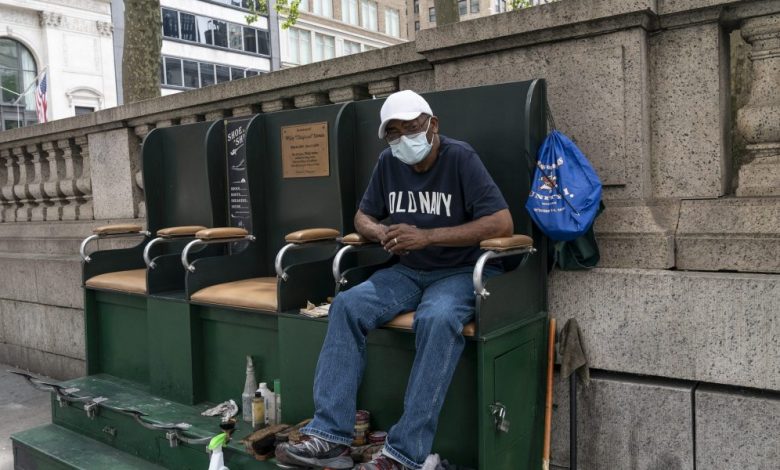Shoeshine economy hit by COVID pandemic, remote work and casual wear

On a winter weekday at Penn Station Shoe Repair and Shoe Shine, men hop onto shoeshine chairs and pull out newspapers and phones to read while shoeshine workers go to work applying polish and elbow grease to loafers, boots, and other leather footwear. When finished, these customers deposit $8 in cash at a counter that has a sign that reads, “We’re not God, but we save soles.”
Shoeshine has a much-vaunted history in the United States In the 1860s, Horatio Alger popularized the American rags-to-riches tale with his book Ragged Dick, about a shoeshine boy (or “bootblack”) who works his way up to wealth. “Shoeshine boys” (and the occasional girl) subsequently starred in countless films and television shows.
Today, the tradition of getting a quick polish at a ragged shoeshine boy’s has dwindled, and many booths resembling those at Penn Station have disappeared across the country. The decline has been exacerbated by the pandemic, teleworking and the rise in popularity of casual wear as people return to the office. SC Johnson, maker of the largest shoe polish brand Kiwi, even said in January that sales of the brand had stopped in the UK due to slowing demand (it’s still sold in the US).
The last time the census listed shoeshine as a distinct business was in 2007, when only 30 businesses were counted. According to market research firm IBISWorld, the broader shoe repair market fell an estimated 23% to $307 million between 2013 and 2023. According to figures from Nielsen, shoe polish sales amounted to 27.3 million units in 2022, down 29% from 2019, a sign of the changes brought about by the pandemic.
Nisan Khaimov, who owns the stand at Penn Station, said his stand would shine 80 to 100 shoes every workday before the pandemic. Now it’s between 30 and 50 on Tuesdays to Thursdays and even fewer on Mondays and Fridays. Hybrid work hurts his business.
“Until people go back to work, the problems won’t be resolved,” said Khaimov, who benefits from commuters who commute in and out of New York City and can’t get their shoes polished where they live. “And it’s not good for landlords and also for tenants like us. So we wait. But eventually things will get back to normal, we hope. But if we don’t know.”
Rory Heenan, 38, an accountant in Philadelphia, said that when he was a little boy he would take the train to work with his father every Friday and watch him shine his shoes.
“I would just sit here as a little guy and watch,” he said. “And here I am, you know, 30 years later, doing the same thing. So it’s certainly something that will be passed down over time.”
Across town, in the corridor between the subway and The Port Authority bus station, Jairo Cardenas is also feeling the pinch. The business at Alpha Shoes Repair Corp., which he has run for 33 years, is down 75% from before the pandemic. He’s just a shoeshine boy of the three he employed before the pandemic. His shoeshine boys used to clean 60 or 70 shoes a day. Now is a good day 10 to 15 seems.
Cardenas’ landlord has given him a rent break, but he’s still struggling and has seen several other shoe shine shops in the area close. Still, he’s noticing a surge in people returning to work and hopes business will slowly return to normal by spring.
Shoe repairs usually bring in more money than shine. At David Mesquita’s Leather Spa, which operates five shoe repair and shine shops, including two in Grand Central, the majority of its business comes from shoe, handbag, and clothing repairs. But shoeshine services are still a key offering to lure people into the Leather Spa locations as they are not available everywhere.
Before the pandemic, Leather Spa had four shoeshine chairs at Grand Central and six rotating shoeshine machines that cleaned about 120 times a day. Nowadays there are three shoeshine boys who will shine 40 or 50 times on the best days.
But Mesquita sees people slowly coming back. His shoeshine count in December 2022 increased by 52% compared to December 2021. Mondays and Fridays are less busy than midweek due to the mixed working hours of office workers.
“Traffic is coming back in, we’re seeing commuters coming in and everything, but we’re still not 100% back to where we were,” Mesquita said.
Mesquita said shoeshine isn’t something that’s going to go away entirely.
“I think it’s just a bit of luxury,” he said. “People like to treat themselves, you know, whether it’s once a week or twice a week or once every two weeks. It is simply beautiful.”
Airports are one of the few remaining places, along with the major transport hubs of cities, where a shoe shine service is reliably offered. Jill Wright is the owner of Executive Shine, which operates shoeshine stations at Denver and Charlotte airports. Their business was destroyed when air travel was suspended.
When the airports reopened, they were empty. The only people who get their shoes polished are pilots and crew, she said, which kept her company going. Now, Wright says her business is still only 35% of what it was in 2019.
“Travel has really changed,” she said. “Companies are starting to come back, but not to the extent that they were.”
Business travel is rebounding, but the US Travel Association projects business travel will still be down 10% in 2023 from 2019 and will return to pre-pandemic levels in 2024. Meanwhile, people dress differently when they travel. Instead of traveling in work clothes, some travelers who still want to have their shoes shined travel in tennis shoes, pull out their dress shoes to polish them, and then put them back in their bags, Wright said.
Like Mesquita, Wright anticipates that demand for shoe polish will never entirely go away because it’s more than just a transactional service. A shine is a moment of connection between two people, especially at an airport where there’s a lot of rush and stress, she said.
“People come for the shoeshine, but they also come for the connection and the conversation and just to relax and talk and be seen and feel some compassion,” she said.



